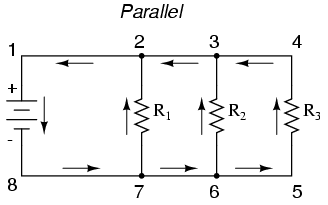In Tuesday's class we reviewed electrical resistance. This determines how much current is drawn from an electrical energy source when an appliance is "plugged in."
Resistance depends on the conductor within it. Resistance of a conductor depends on these four things:
- Length- the more length, the more resistance
- Thickness- thick wire provides less resistance
- Temperature- Higher temperatures lead to higher resistance. Super-conductors have a resistance of near zero when in extremely low temperatures.
- Nature of the Material- different substances provide different resistances.

After this brief review, we went on to learn Ohm's Law
Ohm's Law states that V=IR
- If the voltage is constant, an increase in current (I) must be the result of a decrease of resistance.
- If the resistance is constant, an increase in voltage results in a directly proportional increase in current.
Current generally depends on the voltage and the resistance. However, note that Ohm's Law only works for Ohmic materials. (We won't work be working with any Non-Ohmic materials.)
The total resistance for resistors in series is equal to the sum of each individual resistor.
RS = R1 + R2 + R3 + R4 + __ + Rn
The total resistance for
resistors in parallel is a reciprocal relationship.
1 =
1 +
1 + ...... +
1
R
P R1 R2 Rn
As more resistors are added, the total resistance will become less, thus increasing the voltage.
1.) If a battery maintains a potential difference of 65 Volts across a circuit and a current of 5.0 A flows through it, what is the resistance?
V = 65 V = IR
I = 5.0 R =
V =
65 = 13 Ohm's of resistance
R = ? I 5.0
We concluded the class by going over several examples.
Wednesday's Class
We spent all of Wednesday's class working on practice problems from the text book.
The assignment was:
- Pg. 649 # 1-6
- Pg. 653 # 1-2
- Pg. 655 # 1-2
- Pg. 659 # 1-5
- Pg. 673 # 21 a-e
Brady will post next






